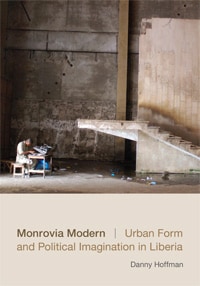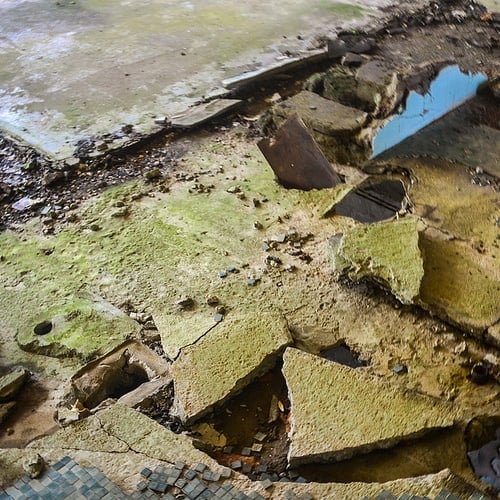Monrovia Modern is a beautiful and perceptive book that describes the limitations and contradictions of architectural forms of political and urban imaginations in Monrovia. It will appeal to both architecture and anthropology scholars concerned with ruins, violence, material culture, photography and West African politics. Hoffman manages the difficult task of “writing Africa into the world” (Mbembe and Nuttall 2004) by depicting in sometimes painfully honest and raw prose the subtleties, perplexities and banalities of Monrovia’s “ruined and ruinous landscape” (6) and the transient lives that inhabit them while avoiding (and convincingly arguing against) a spectacularistic, romanticizing reading of ruin and decay.
 Following an introductory chapter that situates historically and ethnographically the spatial politics of Monrovia and the lives of young ex-combatant men with whom Hoffman has done extensive research, the book unfolds through four architectural portraits of Monrovia’s former iconic buildings of power and influence, now in ruins following decades of violence and inhabited by transient residents striving to “contend with the city’s ruins” (xx): the Ministry of Defense, the E.J. Roye Building (headquarters of Monrovia’s oldest political party, the True Whig Party), Liberia Broadcasting System (LBS), and the hauntingly picturesque Hotel Africa.
Following an introductory chapter that situates historically and ethnographically the spatial politics of Monrovia and the lives of young ex-combatant men with whom Hoffman has done extensive research, the book unfolds through four architectural portraits of Monrovia’s former iconic buildings of power and influence, now in ruins following decades of violence and inhabited by transient residents striving to “contend with the city’s ruins” (xx): the Ministry of Defense, the E.J. Roye Building (headquarters of Monrovia’s oldest political party, the True Whig Party), Liberia Broadcasting System (LBS), and the hauntingly picturesque Hotel Africa.
The book conveys an overwhelming sense of solitude and detachment, of people inhabiting spaces with no intention to dwell in them, professing an active acceptance of their own unmooring from any points of belonging, security, or identity that makes one think again about what it means to “occupy” space and to erase oneself from spatial history.
Hoffman’s book inscribes itself in a well-established field of African urban studies concerned with forms of living, moving about, and strategizing on the city’s immaterialities, informalities and invisible infrastructures (de Boeck 2013 ; Simone 2004). What makes Hoffman’s contribution particularly incisive is his focus on an urban politics of the impossible (Chatterton 2010) in his discussion of the impossibilities of political formation for those “living in the gaps” (48) of the city. While he does describe the creative and imaginative strategies of “storytelling, bluffing, scamming” (41) and strategic navigation (Vigh 2004) deployed by ex-combatant residents, he is more concerned with exploring the “limits to invention” (59) and forms of “creativity without transformation” or “without claim” (55). Indeed, Hoffman’s main aim is to investigate “uninhabitability” as produced in part by the modernist project (and in particular brutalist architecture) and to look at the conditions of impossibilities put forth by certain urban forms that foreclose political and social formations.
As he puts it, “some urban forms work against a population group becoming a political society” – they resist alternative forms of imagination or living (75; emphasis mine); they are “non-subject-producing” (81).
For Hoffman, this uninhabitability stems from the very definition of the modernist project itself (87); he is quick to refuse attributing this impossibility to a distinctly “African modernism” or a defective modernity (87). Rather, he argues, uninhabitability is “a continuous project of invention” (88), one partly weaved through the uncanny comments, rumours, and foreclosed imaginations of the possible fates and histories of those buildings – in the speculation about futures from which their dreamers are removed, excluded by the very obduracy of these ruins. This self-excluded dreaming is an interesting inversion to the process of “conjuring the oneiric” without generating hope described by Filip de Boeck (2011:276) in relation to new luxury building sites in Kinshasa. The residents displaced for the project de Boeck describes, who paradoxically express their enthusiasm for the new gleaming vision of this exclusive development, invoke the contrived and “spectral dimension of the marvellous” that “combines with the dimensions of terror and the dismal” (278). In Monrovia, this erasure of oneself in the dreaming of an alternative, exclusive architectural imaginary conveys an uncanny sense of total respect for authority and the primacy of power (xx) even in the sites of its “necropolitics” (Mbembe 2003).
A fascinating prospect of this study of architectural impossibilities is the way it affords new theorizations on the recalcitrance of material forms to particular social and affective formations.

The four buildings of Monrovia Modern all exhibit a certain recalcitrance to political and social interventions, offering a “bulletproof” façade (as the Ministry of Defence was described in archival accounts – p. 84) that refuses to be peered through even in their ruined form. Yet throughout the book, one would have liked to get a better sense of precisely what kinds of material properties and historical, political and social configurations of architectural matter produce these conditions of recalcitrance and obduracy. For instance, the “thousands of square feet of vacant concrete” (2) that characterize the ruined forms of these buildings would perhaps provide further discussion of the material conditions and manifestations of these impossibilities of dwelling. As the construction material of modernity par excellence, and of brutalist architecture in particular, concrete brings forth the contradictions of modern built forms (Forty 2012). Concrete forces us to “find room for the repugnance” and “repulsion” of materials, to embrace an aesthetics of negativity and impossibility in concrete’s “element of revulsion” and intransigence (Forty 2012:10). Concrete in West Africa is also tied to a popular imaginary of wealth and to the construction boom of the petrostate, associated with Africa’s richest man Aliko Dangote (business magnate and owner of Dangote Cement). One cannot help but wonder if this predominance of raw concrete, which seems to remain, as a ruin, one of the only things that still holds and endures, does not provide another vantage point or perhaps a form of “duress” (Stoler 2016) to rethink the socio-political impossibilities of living in those places.
This is where Hoffman’s strategy of photowriting comes apposite. In the photographs of those ruins, rubbles, and precarious living, there is an uncanny dissonance between the structuring weight of those structures of concrete and the flimsiness of the transient lives intersecting and temporarily inhabiting them. The immobile, gigantic structures of concrete become slightly blurred, effaced, and deranged by the ghostly, shadowed and partial presence of their residents, a photographic disturbance in the architectural order of the buildings. This had the profound effect of bringing out visually the tensions between these material structures and the human forms of survival against which they push. While one may initially regret the absence of a more ethnographic analysis of the lives of those affected by those buildings and living in their ruins, one comes to appreciate this visual rendition instead as a way in which the architectural decay and violence of those ruins came to be felt through this erasure of humanity and their blurred presences.

Monrovia Modern is a thoughtful meditation on both processes of “ruination” (Stoler 2016) and the materiality of ruins (120) in a context in which the construction of many of those buildings designed in utopian post-independence architectural modernism were halted or altered by cycles of violence and political instability. One of the fascinating ideas that emerges from this truncated temporality is the reconsideration of “construction” itself and its teleological fallacy: can the Ministry of Defense or the Liberia Broadcasting House, which were never actually fully built, still be considered ruins or, alternatively, buildings? At which point does a building emerge as “built”, and a ruin become “ruined”? What is the political, social and material salience of an “already-ruined-but-as-yet-unbuilt-structure”? (53). Hoffman’s book proposes an alternative concept of ruin that is not simply defined as a “leftover”, that which comes after, or that which has been destroyed, but a kind of prefigurative ruin that forecloses particular future and generates its own sense of historical revisions.
What emerges is a landscape in which ruination and ruins appear as more banal aspects of life than the suspicious and conspicuous planned visions and dreams of totalizing construction of the political elite.
But one could take this further: Monrovia Modern’s buildings seem to pose a more general question: are buildings by definition “impossible” formations? Is ruination always already implied in the construction project itself? And could there exist alternative imaginaries of coherence and liveability, in ruins? In a fascinating passage, Hoffman describes the incoherence of peace for many ex-combatant residents for whom Monrovia’s violence and poverty “had a kind of coherence missing in the post-Taylor era” (154), signalling a wider disengagement from politics through architectural abandonment. Ibrahim’s (one of the author’s interlocutor) disapproving comment on the authorities’ dereliction of the former Ministry of Health as a “rot” is suggestive of the critical work of the “rot that remains” (Stoler 2013) as material evidence of power’s incapacity to rule, and perhaps of power’s own “sinking power” (the Ministry of Health being referred to as Titanic) and decaying hold (uncannily evidenced in Hoffman’s anecdote that Taylor’s trial was somewhat “overshadowed by the Chelsea vs Barcelona match in the UEFA Champions League” (154)). In that sense, Hoffman also makes a powerful argument about people’s incredible capacities to relinquish, to let go, to move on (de Boeck 2013), against the “productivist” inclinations of the literature on West African strategies of creativity and survival.
Monrovia Modern ends with a powerful coda: the Ebola outbreak of 2014-15 whose quarantine measures of containment in one of Monrovia’s neighbourhood were quickly circumvented by its residents by charging exit fees or negotiating arrangements with the soldiers at the blockades (179). This moment of “magical realism” (181) seems to temporarily reactivate energies and creativities of playing with forms of political ordering that nicely points to what may happen after, and despite the ruins.
Works cited
Chatterton, P., 2010. The urban impossible: a eulogy for the unfinished city. City, 14(3): 234-244.
de Boeck, Filip. 2011. Inhabiting ocular ground: Kinshasa’s future in the light of Congo’s spectral urban politics. Cultural Anthropology, 26(2): 263-286.
de Boeck, 2013. Challenges of urban growth: Toward an anthropology of urban infrastructure in Africa. In: Lepik, A. (ed) Afritecture: building social change, pp. 92-103. Ostfildern: Hatje Cantz.
Forty, A., 2012. Concrete and culture: a material history. London: Reaktion Books.
Mbembe, A., and Nuttal, S., 2004. Writing the world from an African metropolis. Public Culture, 16(3): 347-372.
Mbembe, A., 2003. Necropolitics. Public Culture, 15(1): 11-40.
Simone, A., 2004. For the city yet to come: urban life in four African cities. Durham, N.C., London: Duke University Press.
Stoler, A.L., 2013. “The rot remains”: from ruins to ruination. In: Imperial debris: on ruins and ruination, pp. 1-35. Durham, N.C., London: Duke University Press.
Stoler, A.L., 2016. Duress: imperial durabilities in our times. Durham, N.C., London: Duke University Press.
Vigh, H., 2009. Motion squared: a second look at the concept of social navigation. Anthropological Theory, 9(4): 419-438.
Featured image by jbdodane (flickr, CC BY-NC 2.0)



